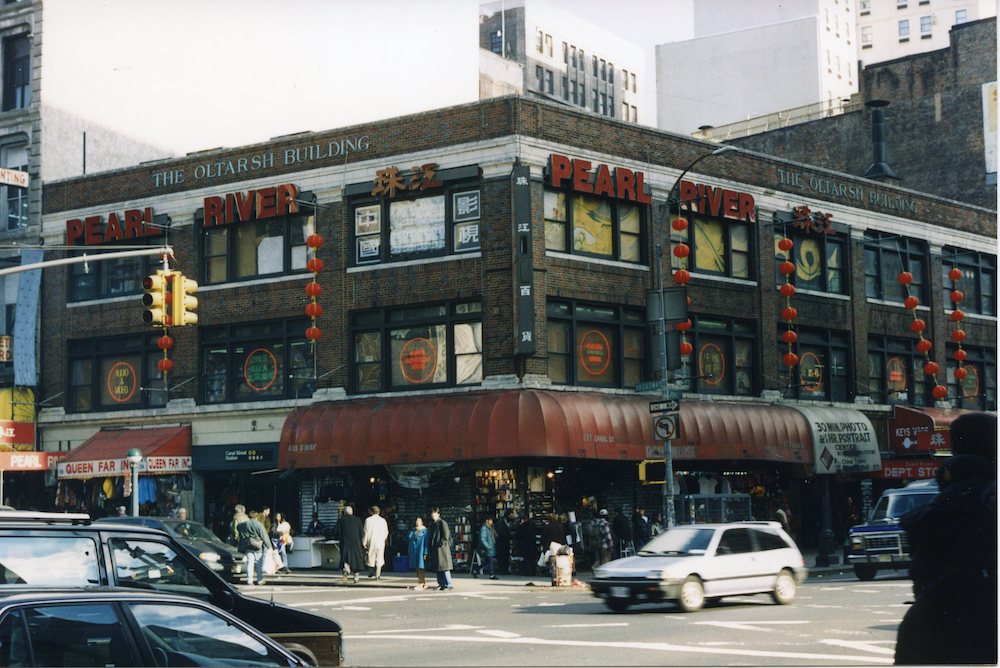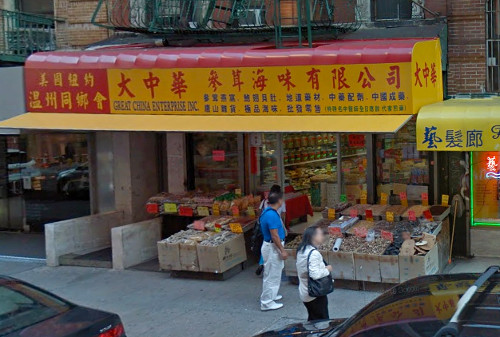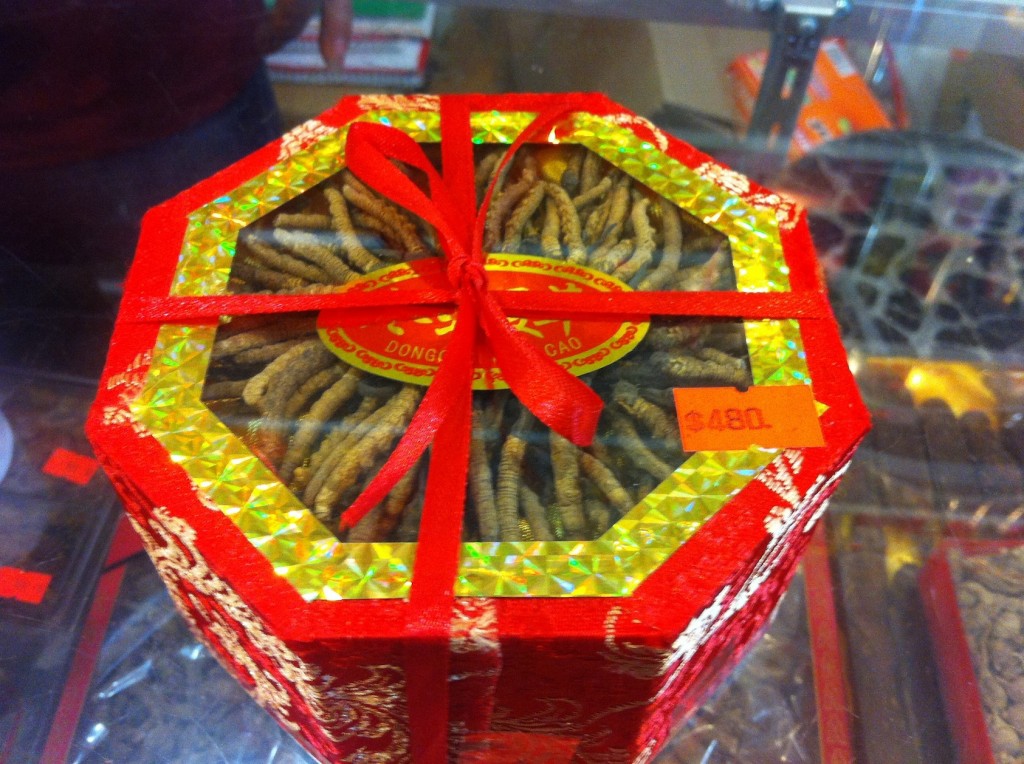Once a Maoist dry-goods business, the store has become a hub for Asian American culture and community

March 6, 2024
When my father first threw open the doors to his small store on Catherine Street in Manhattan’s Chinatown in 1971, he thought the business might last a few years, if that. The store was as much a political experiment as it was a retail venture. Unlike neighboring Chinese shops, which typically marketed curios for tourists or food and sundries for working-class migrant residents, my father’s inventory appealed to a different vision of an incipient postwar diaspora. People’s Liberation Army regalia and socialist-realist propaganda posters celebrating peasant revolution hung on the walls alongside displays of imported soy sauce and cotton hand towels.
Though my father didn’t know it at the time, the store, then known as Si Xin or “Four News” (named after a Cultural Revolution slogan representing “new customs, new culture, new habits, and new ideas” under Mao), marked a new horizon for Chinatown and Asian America—two overlapping communities that bridged global diasporas with an emergent hybridized political identity.
The entrepreneurial crapshoot of a Maoist dry-goods business—which took on the moniker “Friendship Store,” referring to stores in China that catered to Westerners as part of Beijing’s diplomatic outreach—soon turned into a half century of banking on America’s insatiable hunger for, and fascination with, Asian products. As U.S. trade relations with China went from nonexistent to indispensable, the store evolved into a bazaar for all manner of Asian and Asian-inspired objects, from paper fans and porcelain plates to loose teas and loquat syrup. Though the store still carries some tongue-in-cheek Chinese communist accessories, its kitsch and exotica have also been featured by Martha Stewart, Seventeen magazine, and Queer Eye for the Straight Guy.

“Sometimes when you do your career or business, not everything can be under control,” my father, Ming Yi Chen, told me when I sat down with my parents to talk about their upcoming retirement plans. They have been talking about incrementally pulling back from full-time work in the store and taking on more of an advisory role. My father says, “Sometimes you get dragged on, you know, by business itself. So you have no chance to stop and think.”
When the store first opened deep in Chinatown, the community was turning over from an older generation of mostly single men who had settled during the era of Chinese Exclusion, to a wave of families who arrived after the liberalization of immigration in 1965. By the early 1970s, the community was divided between pro-Nationalist and pro-Communist factions, while subaltern Asian American activists and artists were moving in as well. In the middle of all this, my father, fresh out of postdoctoral stint in chemistry at University of Wisconsin–Madison, decided the neighborhood needed a shop that would promote trade with Mainland China.
With the normalization of U.S.–China relations in 1979, the store became a central inlet for a flood of Chinese imports, marketing initially to Chinese immigrants but eventually garnering a customer base as diverse as the city. The business underwent several more moves, each time expanding its inventory to accommodate our “Western” clientele—more brocade fashions and funky oriental tchotchkes, fewer frozen dumplings and instant noodle packets. With each move, the location shifted further away from the center of Chinatown, eventually reaching the edge of one of the city’s priciest shopping districts, the center of Broadway in SoHo. Then in 2015, the landlord of the cavernous storefront threatened to hike the rent by several fold, forcing the store to shutter, triggering an unexpected public outcry.
In the following years, after reopening in a smaller location in Tribeca and getting pushed out again by the landlord, Pearl River eventually relaunched in two more compact spots—a long, high-ceilinged space on a bustling stretch of Broadway, just down the street from its former SoHo location; and the branch furthest from Chinatown, nestled in the upscale food court of the Alphabet-owned shopping complex Chelsea Market.

Longtime shoppers would associate Pearl River with Chinatown, but in reality, the emporium has always belonged much more to the city as a whole, especially in the last two decades, when it became a go-to spot for hipsters, corporate event planners, and college students seeking to accent their outfits, dorms, or holiday parties. The store’s migration over the last twenty years has given it a unique vantage point on how Asian American culture has moved from the fringes to off-center of the cultural mainstream.
For my parents, moving the store outside of Chinatown was a practical decision; as the neighborhood grew, the business found itself amid a sea of “Oriental” knockoffs and cutthroat price competition from other vendors. Pearl River saw its future in catering to customers who would not just snatch up the cheapest version of its products. The company pivoted away from Chinatown’s style of what my father calls “punitive capitalism.”
Had they stayed in the neighborhood, he added, “Maybe you finish a long time ago.” My mother, Ching Yeh Chen, pointed out how several businesses in Chinatown have struggled, saying, “All the businesses who survived at the same time as us are all gone right now.”
Pearl River has survived in part because it has changed with the times—my sister-in-law Joanne Kwong now runs the day-to-day operations and has reoriented the store’s brand around Asian American identity. Many of the customers who come to the store today are younger Asian Americans who are revisiting familiar items in a new light, seeking to reconstruct faded memories or revisit their relationship to their families and their diasporas. The Hello Kitty stationery, rice paper–wrapped milk candies, and stainless-steel lunch tiffins recall weekend grocery runs in Chinatown or their aunt’s tenement apartment that smelled like laundry soap and old talcum powder—memories that Asian Americans may have felt eager to leave behind before, but now want to reclaim. While the store today attracts a racially and socioeconomically heterogeneous mix of customers—bargain hunters, tourists, and local cosmopolitans—Asian Americana, and its fusion of wholesome kitsch with subaltern syncretism, is the cultural lodestar.
The pandemic magnified the emergent racial consciousness that draws people toward that kind of cultural enterprise. The rise in reported violence against Asians across the city, coupled with economic devastation of Chinatown’s restaurants and other businesses as foot traffic dropped with the onset of the pandemic lockdowns, triggered an eruption of community activism, including efforts led by second-generation Asian Americans to revive and protect Chinatown’s shops and eateries. Although Pearl River was no longer in Chinatown at that point, it was still hobbled by the sharp retail slump during the lockdown, and staffers were shaken by the seeming surge in anti-Asian hostility. In addition, the company took on a symbolic role in the politics surrounding the pandemic’s devastation of local commerce and communities. Joanne helped advocate for Asian-owned and ethnic small businesses as part of a citywide coalition pressing the Mayor’s office to provide more support to local small businesses. Seeking partnerships with second-generation cultural entrepreneurs, Pearl River also collaborated with Gold House, an association of Asian American “creatives,” to feature start-up brands of their “Founders Network” in the store, like sunglass frames designed to fit East Asian faces.
When the store opened its new gallery space in 2021—a tiny back room behind the new SoHo store, it solidified its role as an AAPI community hub—its inaugural exhibit commemorated the career of Chinatown’s late resident photographer, Corky Lee. Several Asian American photographers who had either worked alongside or been mentored by Corky gathered to present images of Asian American life, from scenes of a children’s martial arts class to ghostly vistas of locked-down Chinatown streets. Last summer, the gallery showed a collection of graphic miscellany from the archives of Arlan Huang, an alumnus of the Asian American guerilla art collective Basement Workshop.

Pearl River’s latest offspring, a cozy grocery shop in the Chelsea Market food hall, is part of its pivot to Asian American culture, featuring a rotating assembly of pop-up food vendors serving Instagram-ready quick eats like laksa and steamed bao, alongside a small grocery with hyphenated ethnic snacks like Black Truffle Masala popcorn. For the Mid-Autumn festival, Pearl River Mart Foods promoted artisanal mooncakes from a baking-kit delivery service founded by the daughter of Chinatown restaurateurs. A few weeks later, the store hosted its first Diwali sweets tasting, a reflection of how its brand now encompasses a pan-Asian identity.
But despite generating fresh energy from AAPI entrepreneurs and serving as a venue for celebrating Asian American history, in the long term, the churn of capitalism does not play well with the company’s grassroots cultural aspirations. Pearl River will still struggle to turn its niche into a sustainable business in a city where many brick-and-mortar retailers are barely treading water against the tides of soaring commercial rents and ruthless competition from online outlets.
Businesses in Pearl River’s spiritual home, Chinatown, are similarly dealing with grotesque real estate costs and gentrification, on top of the neighborhood’s corroding infrastructure, amid a general deconcentration of the city’s Chinese immigrant population. The challenges facing legacy immigrant businesses paradoxically coincide with a boom for the AAPI middle class, which has seen a dramatic rise in income over the last generation. At the same time, class polarization between working-class and elite Asian Americans has also expanded faster than for other groups. The community Pearl River has cultivated seeks to straddle that class divide, and the business is banking on the hope that second-generation consumers will see value in a retail brand that blends preservation and innovation. There are likely more young Asian American professionals than fresh arrivals from Fujian milling about the bulbous hanging lanterns and Lucky Cat displays. But the store’s aesthetic radiates an earnest respect for its migrant and diasporic roots, even if the customers’ sensibilities embrace their parent cultures with an ironic wink.

Joanne still sees Pearl River as a “Chinatown store,” first and foremost, but the mission of the business is also to extend the edges of the neighborhood. She says Pearl River might eventually set up smaller branches in other cities, as a way of extending the reach of its brand while not being so dependent on doing business in Manhattan. That means Pearl River’s next migration may be well outside of New York City, seeking a niche market in another urban center where Asian American culture is flourishing.
Old-school fans of the store might complain that Pearl River has strayed too far from its Chinatown roots by modernizing its inventory and angling for a younger, more eclectic customer base. But Joanne mused, “I like the fact that Pearl River’s history has always been about pushing outside the boundaries of Chinatown.”
Looking back over the last eight years, over the spaces Pearl River has occupied and vacated inside Chinatown and out, my mother said she discovered something about the loyal customers who were always eager to see the store reopen in whatever form. “I think we learned that Pearl River, or this business idea, has a place in this country,” she said.
My family’s store is still mapping out where that place is. The space it occupies now is not really Chinatown, but the city’s imagination, the social firmament suspending the objects and ephemera that texturized and illuminated generations of Asian American life. As the Friendship Store changes hands to the next generation, the legacy surfacing is not just a product or particular location, but a story the community is crafting from its collective memory.



